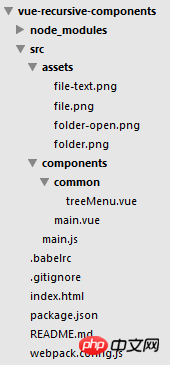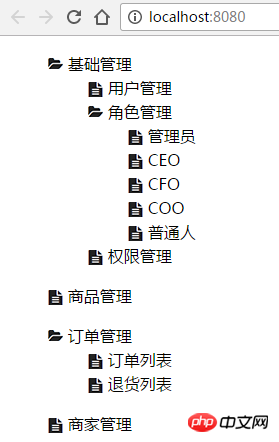Vue.js recursive component implements tree menu
This article mainly introduces the use of recursive components of Vue.js to implement a basic tree menu. It has a very good reference value, let’s take a look at it together
I recently looked at the recursive component of Vue.js and implemented a basic tree menu.
Project structure:

main.js As the entrance, it is very simple:
import Vue from 'vue'
Vue.config.debug = true
import main from './components/main.vue'
new Vue({
el: '#app',
render: h => h(main)
})it A component main.vue is introduced:
<template>
<p class="tree-menu">
<ul v-for="menuItem in theModel">
<my-tree :model="menuItem"></my-tree>
</ul>
</p>
</template>
<script>
var myData = [
{
'id': '1',
'menuName': '基础管理',
'menuCode': '10',
'children': [
{
'menuName': '用户管理',
'menuCode': '11'
},
{
'menuName': '角色管理',
'menuCode': '12',
'children': [
{
'menuName': '管理员',
'menuCode': '121'
},
{
'menuName': 'CEO',
'menuCode': '122'
},
{
'menuName': 'CFO',
'menuCode': '123'
},
{
'menuName': 'COO',
'menuCode': '124'
},
{
'menuName': '普通人',
'menuCode': '124'
}
]
},
{
'menuName': '权限管理',
'menuCode': '13'
}
]
},
{
'id': '2',
'menuName': '商品管理',
'menuCode': ''
},
{
'id': '3',
'menuName': '订单管理',
'menuCode': '30',
'children': [
{
'menuName': '订单列表',
'menuCode': '31'
},
{
'menuName': '退货列表',
'menuCode': '32',
'children': []
}
]
},
{
'id': '4',
'menuName': '商家管理',
'menuCode': '',
'children': []
}
];
import myTree from './common/treeMenu.vue'
export default {
components: {
myTree
},
data() {
return {
theModel: myData
}
}
}
</script>This file introduces a tree component treeMenu.vue:
<template>
<li>
<span @click="toggle">
<i v-if="isFolder" class="icon" :class="[open ? 'folder-open': 'folder']"></i>
<i v-if="!isFolder" class="icon file-text"></i>
{{ model.menuName }}
</span>
<ul v-show="open" v-if="isFolder">
<tree-menu v-for="item in model.children" :model="item"></tree-menu>
</ul>
</li>
</template>
<script>
export default {
name: 'treeMenu',
props: ['model'],
data() {
return {
open: false,
isFolder: true
}
},
computed: {
isFolder: function() {
return this.model.children && this.model.children.length
}
},
methods: {
toggle: function() {
if (this.isFolder) {
this.open = !this.open
}
}
}
}
</script>
<style>
ul {
list-style: none;
}
i.icon {
display: inline-block;
width: 15px;
height: 15px;
background-repeat: no-repeat;
vertical-align: middle;
}
.icon.folder {
background-image: url(/src/assets/folder.png);
}
.icon.folder-open {
background-image: url(/src/assets/folder-open.png);
}
.icon.file-text {
background-image: url(/src/assets/file-text.png);
}
.tree-menu li {
line-height: 1.5;
}
</style>It’s that simple. There’s really nothing to write about in this article, let’s just keep it as a record.
The screenshot effect is as follows:

The above is the entire content of this article. I hope it will be helpful to everyone's study. For more related content, please pay attention to the PHP Chinese website !
Related recommendations:
Analysis on the separation and combination of vue-admin and backend (flask)
Based on the Vue framework Introduction to the pull-up refresh function of the vux component library
The above is the detailed content of Vue.js recursive component implements tree menu. For more information, please follow other related articles on the PHP Chinese website!

Hot AI Tools

Undresser.AI Undress
AI-powered app for creating realistic nude photos

AI Clothes Remover
Online AI tool for removing clothes from photos.

Undress AI Tool
Undress images for free

Clothoff.io
AI clothes remover

Video Face Swap
Swap faces in any video effortlessly with our completely free AI face swap tool!

Hot Article

Hot Tools

Notepad++7.3.1
Easy-to-use and free code editor

SublimeText3 Chinese version
Chinese version, very easy to use

Zend Studio 13.0.1
Powerful PHP integrated development environment

Dreamweaver CS6
Visual web development tools

SublimeText3 Mac version
God-level code editing software (SublimeText3)

Hot Topics
 In-depth discussion of how vite parses .env files
Jan 24, 2023 am 05:30 AM
In-depth discussion of how vite parses .env files
Jan 24, 2023 am 05:30 AM
When using the Vue framework to develop front-end projects, we will deploy multiple environments when deploying. Often the interface domain names called by development, testing and online environments are different. How can we make the distinction? That is using environment variables and patterns.
 Detailed graphic explanation of how to integrate the Ace code editor in a Vue project
Apr 24, 2023 am 10:52 AM
Detailed graphic explanation of how to integrate the Ace code editor in a Vue project
Apr 24, 2023 am 10:52 AM
Ace is an embeddable code editor written in JavaScript. It matches the functionality and performance of native editors like Sublime, Vim, and TextMate. It can be easily embedded into any web page and JavaScript application. Ace is maintained as the main editor for the Cloud9 IDE and is the successor to the Mozilla Skywriter (Bespin) project.
 What is the difference between componentization and modularization in vue
Dec 15, 2022 pm 12:54 PM
What is the difference between componentization and modularization in vue
Dec 15, 2022 pm 12:54 PM
The difference between componentization and modularization: Modularization is divided from the perspective of code logic; it facilitates code layered development and ensures that the functions of each functional module are consistent. Componentization is planning from the perspective of UI interface; componentization of the front end facilitates the reuse of UI components.
 Explore how to write unit tests in Vue3
Apr 25, 2023 pm 07:41 PM
Explore how to write unit tests in Vue3
Apr 25, 2023 pm 07:41 PM
Vue.js has become a very popular framework in front-end development today. As Vue.js continues to evolve, unit testing is becoming more and more important. Today we’ll explore how to write unit tests in Vue.js 3 and provide some best practices and common problems and solutions.
 How to query the current vue version
Dec 19, 2022 pm 04:55 PM
How to query the current vue version
Dec 19, 2022 pm 04:55 PM
There are two ways to query the current Vue version: 1. In the cmd console, execute the "npm list vue" command to query the version. The output result is the version number information of Vue; 2. Find and open the package.json file in the project and search You can see the version information of vue in the "dependencies" item.
 A simple comparison of JSX syntax and template syntax in Vue (analysis of advantages and disadvantages)
Mar 23, 2023 pm 07:53 PM
A simple comparison of JSX syntax and template syntax in Vue (analysis of advantages and disadvantages)
Mar 23, 2023 pm 07:53 PM
In Vue.js, developers can use two different syntaxes to create user interfaces: JSX syntax and template syntax. Both syntaxes have their own advantages and disadvantages. Let’s discuss their differences, advantages and disadvantages.
 Let's talk in depth about reactive() in vue3
Jan 06, 2023 pm 09:21 PM
Let's talk in depth about reactive() in vue3
Jan 06, 2023 pm 09:21 PM
Foreword: In the development of vue3, reactive provides a method to implement responsive data. This is a frequently used API in daily development. In this article, the author will explore its internal operating mechanism.
 A brief analysis of how vue implements file slicing upload
Mar 24, 2023 pm 07:40 PM
A brief analysis of how vue implements file slicing upload
Mar 24, 2023 pm 07:40 PM
In the actual development project process, sometimes it is necessary to upload relatively large files, and then the upload will be relatively slow, so the background may require the front-end to upload file slices. It is very simple. For example, 1 A gigabyte file stream is cut into several small file streams, and then the interface is requested to deliver the small file streams respectively.






